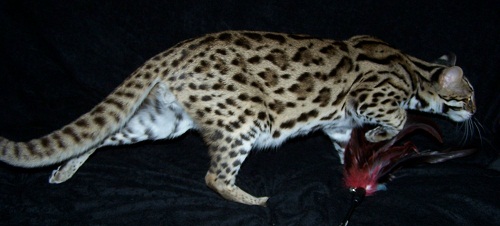A Bengal Cat is a unique breed resulting from crossing an Asian Leopard Cat with a domestic cat. You get the wild look and beauty of a Leopard Cat, but only in pet form. The first generation offspring (F1) is the result of mating an Asian Leopard Cat with a domestic cat. This would also include the F2's and F3's. An F4 and beyond (also called an SBT) is considered to be the domestic Bengal. After 3 generations of Bengal to Bengal breeding, the breed is recognized for championship competition by most International Domestic Cat Associations.
From about three weeks of age until about 16 weeks, kittens have a fuzzy gray look to them that blurs their markings and affects their color. This is known as the "ugly fuzzies" and it will gradually disappear. Their markings and beautiful coat will develop, and you will not be disappointed. A Bengals markings can take up to a year or sometimes longer to completely develop. Bengals are very friendly and lovable when socialized properly. Most of them LOVE water. This is something that they inherit through their wild heritage. Don't be surprised if they decide to join you when you take a shower. They come running when they hear you turn on a faucet. They will "help" you wash dishes and also be right there while you brush your teeth. Bengals have "puppy personalities", their playful antics are amazing.
From about three weeks of age until about 16 weeks, kittens have a fuzzy gray look to them that blurs their markings and affects their color. This is known as the "ugly fuzzies" and it will gradually disappear. Their markings and beautiful coat will develop, and you will not be disappointed. A Bengals markings can take up to a year or sometimes longer to completely develop. Bengals are very friendly and lovable when socialized properly. Most of them LOVE water. This is something that they inherit through their wild heritage. Don't be surprised if they decide to join you when you take a shower. They come running when they hear you turn on a faucet. They will "help" you wash dishes and also be right there while you brush your teeth. Bengals have "puppy personalities", their playful antics are amazing.
About Bengals
Asian Leopard Cat (prionailurus bengalensis)
The Asian Leopard Cat ( Felis bengalensis ) is built similar to a normal domestic cat, but with somewhat longer legs and a longer back. They have a relatively small head with a short narrow muzzle, large eyes (because of their nocturnal habits) and a thick tail of about 11 to 14 inches length. Body length varies between 25 to 32 inches, and they weigh between 7 to 15 pounds on average. Size and weight vary between subspecies in different geographical regions, but the males are generally heavier than the females.
The Asian Leopard Cat ( Felis bengalensis ) is built similar to a normal domestic cat, but with somewhat longer legs and a longer back. They have a relatively small head with a short narrow muzzle, large eyes (because of their nocturnal habits) and a thick tail of about 11 to 14 inches length. Body length varies between 25 to 32 inches, and they weigh between 7 to 15 pounds on average. Size and weight vary between subspecies in different geographical regions, but the males are generally heavier than the females.
The catsí beautiful markings, which have in many ways been their downfall by attracting the attention of the fur trade, are striking and show some variation between individuals. All subspecies have a spotted or ringed tail, with a black tail tip, four black bands running from the forehead to the back of the neck, breaking up into elongated spots on the neck and shoulders, often forming a " broken necklace". The round black ears have a white spot (oceli) on the back, and all cats have a white underside, throat and cheek-flashes. The underparts are spotted on the white background. The body markings can be solid or rosetted and sometimes show marbling.
ALC = Asian Leopard Cat
F1 (A1S) = First generation cross between an ALC
and another Bengal, usually an SBT
F2 (B2S) = A Bengal that is two generations
removed from the ALC
F3 (C3S) = A Bengal that is three generations
removed from the ALC
SBT = Stud Book Tradition - This is the TICA
definition for any purebred cat that has 3 previous
generations of same breed-to-same
breed mating in its 3 generation pedigree.
This means 3 generations of
Bengal-to-Bengal breeding, without an
ALC in the 3 generation pedigree.
F1 (A1S) = First generation cross between an ALC
and another Bengal, usually an SBT
F2 (B2S) = A Bengal that is two generations
removed from the ALC
F3 (C3S) = A Bengal that is three generations
removed from the ALC
SBT = Stud Book Tradition - This is the TICA
definition for any purebred cat that has 3 previous
generations of same breed-to-same
breed mating in its 3 generation pedigree.
This means 3 generations of
Bengal-to-Bengal breeding, without an
ALC in the 3 generation pedigree.



Copyright © 2006-2021
All Rights Reserved
TICA Registered Cattery
KyBengalBabyz
All the contents of this website are copyright of KyBengalBabyz,
and are not to be used or copied without written consent.
All Rights Reserved
TICA Registered Cattery
KyBengalBabyz
All the contents of this website are copyright of KyBengalBabyz,
and are not to be used or copied without written consent.
